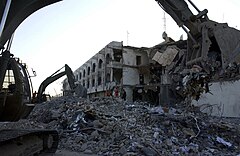Jama'at al-Tawhid wal-Jihad
[2][17] After several mergers with other groups and the formation of the Mujahideen Shura Council, it changed its name several times until it called itself Islamic State of Iraq (ISI) in 2006.
Abu Musab al-Zarqawi was a Jordanian Jihadist who traveled to Afghanistan to fight within the Soviet–Afghan War, but arrived after the departure of the Soviet troops, and soon returned to his homeland.
[18] A report released by the Washington Institute for Near East Policy in mid-2014 describes al-Zarqawi, in association with other Jordanians and Sunni Jihadist militants, as starting JTJ in 1999 with its training camp in Herat, and with "a small amount of seed money" from bin Laden "which continued until 9/11".
[41] The group pledged allegiance to Osama bin Laden's al-Qaeda network in a letter in October 2004 and changed its name to Tanzim Qaidat al-Jihad fi Bilad al-Rafidayn.
[2][24][25] That same month, the group, now popularly referred to as al-Qaeda in Iraq (AQI), kidnapped and killed Japanese citizen Shosei Koda.
In November, al-Zarqawi's network was the main target of the US Operation Phantom Fury in Fallujah, but its leadership managed to escape the American siege and subsequent storming of the city.
The Lebanese-Palestinian militant group Fatah al-Islam, which was defeated by Lebanese government forces during the 2007 Lebanon conflict, was linked to AQI and led by al-Zarqawi's former companion Mustafa Ramadan Darwish who had fought alongside him in Iraq.



